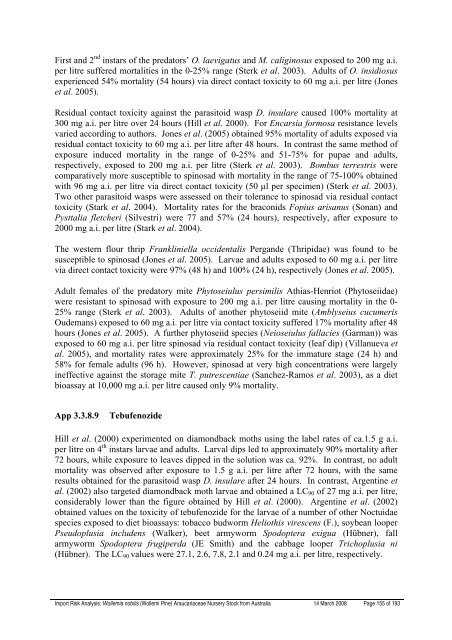Wollemia nobilis (Wollemi Pine) - Biosecurity New Zealand
Wollemia nobilis (Wollemi Pine) - Biosecurity New Zealand
Wollemia nobilis (Wollemi Pine) - Biosecurity New Zealand
You also want an ePaper? Increase the reach of your titles
YUMPU automatically turns print PDFs into web optimized ePapers that Google loves.
First and 2 nd instars of the predators’ O. laevigatus and M. caliginosus exposed to 200 mg a.i.<br />
per litre suffered mortalities in the 0-25% range (Sterk et al. 2003). Adults of O. insidiosus<br />
experienced 54% mortality (54 hours) via direct contact toxicity to 60 mg a.i. per litre (Jones<br />
et al. 2005).<br />
Residual contact toxicity against the parasitoid wasp D. insulare caused 100% mortality at<br />
300 mg a.i. per litre over 24 hours (Hill et al. 2000). For Encarsia formosa resistance levels<br />
varied according to authors. Jones et al. (2005) obtained 95% mortality of adults exposed via<br />
residual contact toxicity to 60 mg a.i. per litre after 48 hours. In contrast the same method of<br />
exposure induced mortality in the range of 0-25% and 51-75% for pupae and adults,<br />
respectively, exposed to 200 mg a.i. per litre (Sterk et al. 2003). Bombus terrestris were<br />
comparatively more susceptible to spinosad with mortality in the range of 75-100% obtained<br />
with 96 mg a.i. per litre via direct contact toxicity (50 µl per specimen) (Sterk et al. 2003).<br />
Two other parasitoid wasps were assessed on their tolerance to spinosad via residual contact<br />
toxicity (Stark et al. 2004). Mortality rates for the braconids Fopius arisanus (Sonan) and<br />
Pysttalia fletcheri (Silvestri) were 77 and 57% (24 hours), respectively, after exposure to<br />
2000 mg a.i. per litre (Stark et al. 2004).<br />
The western flour thrip Frankliniella occidentalis Pergande (Thripidae) was found to be<br />
susceptible to spinosad (Jones et al. 2005). Larvae and adults exposed to 60 mg a.i. per litre<br />
via direct contact toxicity were 97% (48 h) and 100% (24 h), respectively (Jones et al. 2005).<br />
Adult females of the predatory mite Phytoseiulus persimilis Athias-Henriot (Phytoseiidae)<br />
were resistant to spinosad with exposure to 200 mg a.i. per litre causing mortality in the 0-<br />
25% range (Sterk et al. 2003). Adults of another phytoseiid mite (Amblyseius cucumeris<br />
Oudemans) exposed to 60 mg a.i. per litre via contact toxicity suffered 17% mortality after 48<br />
hours (Jones et al. 2005). A further phytoseiid species (Neioseiulus fallacies (Garman)) was<br />
exposed to 60 mg a.i. per litre spinosad via residual contact toxicity (leaf dip) (Villanueva et<br />
al. 2005), and mortality rates were approximately 25% for the immature stage (24 h) and<br />
58% for female adults (96 h). However, spinosad at very high concentrations were largely<br />
ineffective against the storage mite T. putrescentiae (Sanchez-Ramos et al. 2003), as a diet<br />
bioassay at 10,000 mg a.i. per litre caused only 9% mortality.<br />
App 3.3.8.9 Tebufenozide<br />
Hill et al. (2000) experimented on diamondback moths using the label rates of ca.1.5 g a.i.<br />
per litre on 4 th instars larvae and adults. Larval dips led to approximately 90% mortality after<br />
72 hours, while exposure to leaves dipped in the solution was ca. 92%. In contrast, no adult<br />
mortality was observed after exposure to 1.5 g a.i. per litre after 72 hours, with the same<br />
results obtained for the parasitoid wasp D. insulare after 24 hours. In contrast, Argentine et<br />
al. (2002) also targeted diamondback moth larvae and obtained a LC90 of 27 mg a.i. per litre,<br />
considerably lower than the figure obtained by Hill et al. (2000). Argentine et al. (2002)<br />
obtained values on the toxicity of tebufenozide for the larvae of a number of other Noctuidae<br />
species exposed to diet bioassays: tobacco budworm Heliothis virescens (F.), soybean looper<br />
Pseudoplusia includens (Walker), beet armyworm Spodoptera exigua (Hübner), fall<br />
armyworm Spodoptera frugiperda (JE Smith) and the cabbage looper Trichoplusia ni<br />
(Hübner). The LC90 values were 27.1, 2.6, 7.8, 2.1 and 0.24 mg a.i. per litre, respectively.<br />
Import Risk Analysis: <strong><strong>Wollemi</strong>a</strong> <strong>nobilis</strong> (<strong>Wollemi</strong> <strong>Pine</strong>) Araucariaceae Nursery Stock from Australia 14 March 2008 Page 155 of 193

















